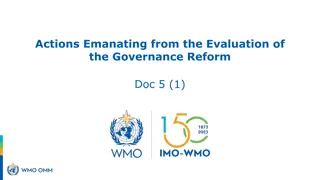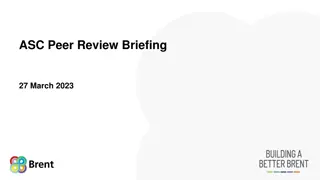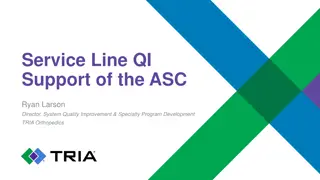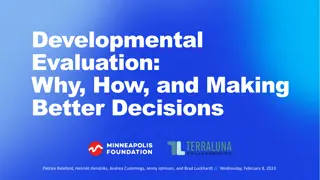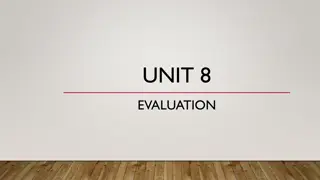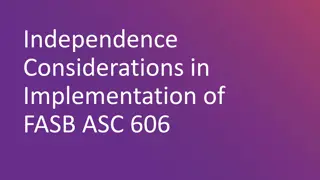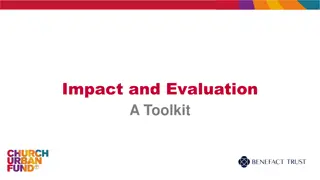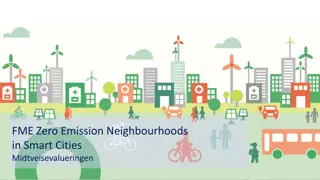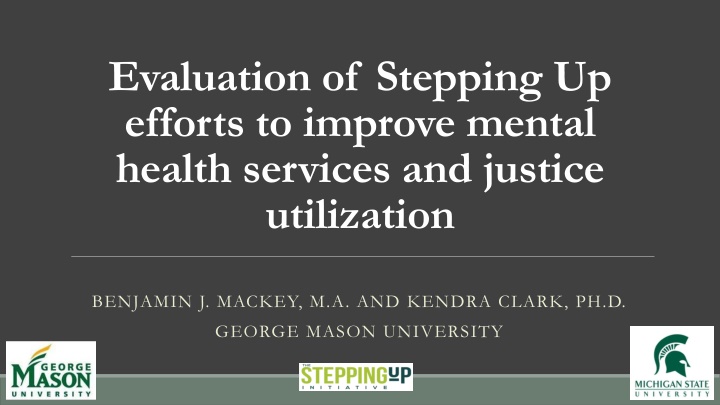
Evaluating Stepping Up Initiative: Improving Mental Health Services and Justice Utilization
This research project evaluates the Stepping Up Initiative funded by NIMH, focusing on mental health and justice systems. The study involves surveys in multiple counties over several years to assess the program's impact and effectiveness in implementing Evidence-Based Practices.
Download Presentation

Please find below an Image/Link to download the presentation.
The content on the website is provided AS IS for your information and personal use only. It may not be sold, licensed, or shared on other websites without obtaining consent from the author. If you encounter any issues during the download, it is possible that the publisher has removed the file from their server.
You are allowed to download the files provided on this website for personal or commercial use, subject to the condition that they are used lawfully. All files are the property of their respective owners.
The content on the website is provided AS IS for your information and personal use only. It may not be sold, licensed, or shared on other websites without obtaining consent from the author.
E N D
Presentation Transcript
Evaluation of Stepping Up efforts to improve mental health services and justice utilization BENJAMIN J. MACKEY, M.A. AND KENDRA CLARK, PH.D. GEORGE MASON UNIVERSITY
What is our study? Research project funded by the National Institute of Mental Health (R01 MH118680) Evaluating the Stepping Up Initiative Taking place beginning September 2019 through August 2024 This is an implementation research study
Methods: Counties and Time Frames We will survey 4 people each from 475 Stepping Up and 475 matched comparison counties: Behavioral health administrator Jail administrator Probation chief Substance abuse administrator Surveys will take place at study baseline, 18 months, and 36 months later This will result in over 11,000 potential interviews in addition to 270 qualitative interviews
Stepping Up Strategies Mechanisms Outcomes Use/functioning of interagency teams Convene policy team Identify MH screening tool; develop capacity to use screening tool and track 4 specific indicators on an ongoing basis # Clients served with EBPP Logic Model Use of/capacity for performance monitoring Collect baseline data using the screening tool # EBPP available Track implementation progress on an ongoing basis using the screening took and the 4 indicators $ spent on EBPP Analyze existing community and jail services and make a plan for addressing gaps Common goals/mission across agencies and System integration Implement the plan and prioritize funds
What will we know when were done? This study of an ongoing natural experiment (i.e., Stepping Up) is an unprecedented opportunity to evaluate multi-system justice and mental health implementation efforts on a national scale to elucidate effective strategies for bringing Evidence- Based practices to vulnerable and underserved populations
Gaps in Service Delivery are Problematic 28% of Counties Participate in Demonstration Projects (Federal Grants) Medically served counties: Higher proportion of counties participating in initiatives Concentrated in the West and Northeast Medically underserved counties: Concentrated throughout the south and north-central US Less likely to participate in Federal Grants) *MUA refers to counties that are medically underserved for mental health. The metric is calculated by HRSA 7
Availability of Mental Health Evidence-Based Practices and Policies across U.S. counties % of Counties % of US Population Practice Diversion from criminal justice action to mental health treatment Problem solving court Crisis Intervention Teams (co-responding model) Crisis call-in centers Mental health treatment required by the court Shared decision making in mental health treatment planning Coordination between jail and community services (hand-off) Medicaid eligibility continuity Mental health peer navigators, peer advocacy, or peer support Permanent supportive housing for individuals with mental health conditions Supported employment for individuals with mental health conditions Family or caregiver education and support about the patient s mental illness Trauma-informed care, settings, or services 36.7 41.6 35.9 40.3 42.0 35.8 75.7 86.9 74.0 80.0 87.9 70.8 Available but not accessible (small ns) 38.3 79.3 29.3 34.2 29.2 30.6 31.1 36.6 57.1 71.6 62.5 62.0 63.2 76.5
% of US Populati on 88.2 % of Counties Any treatment for depression Cognitive-behavior therapy (CBT) or Behavioral Activation 43.0 40.5 78.1 Interpersonal psychotherapy (IPT) 25.9 50.8 Selective serotonin reuptake inhibitors 33.1 61.9 Diagnosis-Specific Mental Health Treatments Any treatment for post-traumatic stress disorder (PTSD) Cognitive-behavioral therapy processing therapy Prolonged exposure Seeking Safety 40.7 85.2 (CBT) or cognitive 41.0 77.4 25.8 31.8 50.6 61.5 SSRIs or tricyclic antidepressants 37.4 69.1 Anticonvulsants for re-experiencing 25.2 47.0 Any treatment for anxiety 40.5 78.1 Exposure therapies or cognitive-behavioral therapy (CBT) 36.0 68.4 SSRIs or tricyclic antidepressants 37.6 71.1
With 10.3 million jail admittances per year many of them individuals with behavioral health conditions (SMI/SUD) counties across the country are implementing evidence-based practices to reform the jail system National Initiatives Grant Programs Evidence-Based Practices Umbrella Stepping Up Friendly Faces MacArthur Safety & Justice Challenge Etc. Second Chance Act HEAL CSAT drug court initiatives Etc. Programs/Policies (EBPPs) Treatments (EBTs) Diversion programs Drug/MH courts Case management (FACT, FICM) Etc. Condition-specific CBT Medication Family education Etc. But what kind of strategies do counties use?
Implementation Approaches Four latent constructs were developed to measure implementation approaches Relationship-Building: strategies agencies use to form relationships with other agencies within their county and/or state, consisted of nine items with a Cronbach alpha reliability measure of .908. Capacity-Building: overall behavioral healthcare service capacity improvement strategies of different agencies within counties, consisted of six items with an alpha reliability measure of .770. Quality Programming: programming and performance monitoring efforts of counties, consisted of 11 items with an alpha reliability measure of .866. Shared Definitions: development of agreed-up definitions across agencies such as mental illness, recidivism; consisted of three items with an alpha reliability measure of .904
RelationshipBuilding CapacityBuilding Quality Programming Shared Definitions
How do counties of different sizes utilize the implementation strategies? Level of Utilization Large Counties Medium Counties Small Counties High Moderate Low Relationship Building Capacity Building Quality Programming Shared Definitions Which strategies were associated with participation in initiatives/grants? (while controlling for relevant county characteristics) Which strategies were associated with higher numbers of EBPPs/EBTs in counties? (while controlling for relevant county characteristics) National Initiatives Grant Programs Type of Association EBPPs EBTs Strong Potential
Take-Away Points The Impact Of Implementation Approaches The Challenges To Using Implementation Approaches Implementation approaches may help establish more robust programs (more collaborations, higher capacity, better quality) Can help overcome implementation challenges (e.g., lack of fidelity, staff turnover) Smaller counties tend to underutilize implementation approaches Especially Capacity Building and Quality Programming May need more resources to use the approaches Relationship Building seems especially impactful Capacity Building underutilized by counties of all sizes May be challenging as it requires more resources to initiate
Examining Cascade of Care for Justice Involved Individuals with Substance Use and Mental Health Needs
Background Substance use and mental health disorders in justice-involved populations 44% have a mental health disorder compared to 21% of the general population 63% of individuals in county jails met SUD criteria compared to 5% of the general population SUD and mental health needs are associated with numerous undesirable outcomes for this population Jails and prisons have become the largest provider for behavioral health services Capacity to treat in the community is often limited especially in rural communities and those servicing low-income and minority populations
Cascade of Care Method of tracking individuals through stages of care from identification to treatment completion Screened In Need of Treatment Provides an objective view of which stages may be inhibiting quality care Referred to Treatment Previously used in HIV/AIDS, Diabetes, etc. Initiation of Treatment Found that targeting gaps at each individual stage of the cascade was more effective than attempting to improve care as a whole Treatment Engagement Assists in: Targeting where policy and implementation require attention Planning treatment capacity for long term health issues Improving quality of care and data tracking Continuing Care
Screened In Need of Treatment Referred to Treatment Initiation of Treatment Treatment Engagement Continuing Care
Study Aims and Methods Explore whether patterns exist on how agencies move clients through the cascade of care for mental health (MH) and substance use disorder (SUD) treatment. Method: Latent Class Analysis to identify patterns among PRACTITIONER REPORTED rates of positive screening, treatment referrals, and treatment engagement. Examine the characteristics of agencies that report shortfalls and gaps in care at various stages of the cascade. Method: Compare characteristics of agencies included in each latent class, as well as the group of agencies that reported not knowing their rates of use. Examine factors that predict class membership. Method: Simultaneous estimation of classes and predictors of class membership using GSEM
Progression of MH and SUD Care by Latent Class 100 90 80 70 60 Screened Positive-MH Referred-MH Entered Treatment-MH Screened Positive-SUD Referred-SUD Entered Treatment-SUD 50 40 30 20 10 0 Low Utilization n=54 (7%) High Utilization n=153 (19%) SUD Focused n=157 (20%) Low Needs/High Provision n=115 (15%) Classes
Characteristics by Class Differences that may explain the differences in service efficiency between classes
Discussion and Implications Rural counties have unique needs that must be addressed Specialized staffing and Evidence-Based practices can help close the gaps in the cascade of care Increasing jail data collection capacity and communication across agencies will help increase provision of care
Contact Us Benjamin J. Mackey, MA, Research Associate Kendra J. Clark, Ph.D., Research Associate Center for Advancing Correctional Excellence! Center for Advancing Correctional Excellence! George Mason University George Mason University email: bmackey2@gmu.edu email: kclark45@gmu.edu Twitter: @BenJMackey Twitter: @KendraJClark
1 2 3 4 5 6 7 8 Log likelihood -9495.58 -9287.06 -9227.92 -9102.68 -9067.62 -9004.30 -9013.08 -8985.53 BIC 19065.22 18691.38 18616.3 18409.03 18382.12 18298.68 18359.44 18347.53 AIC 19015.16 18612.12 18507.84 18271.37 18215.25 18102.61 18134.17 18093.06 Entropy 0.791 0.738 0.773 0.779 0.777 0.752 0.742 % re-classified 37 42 27 4 11 14 18

